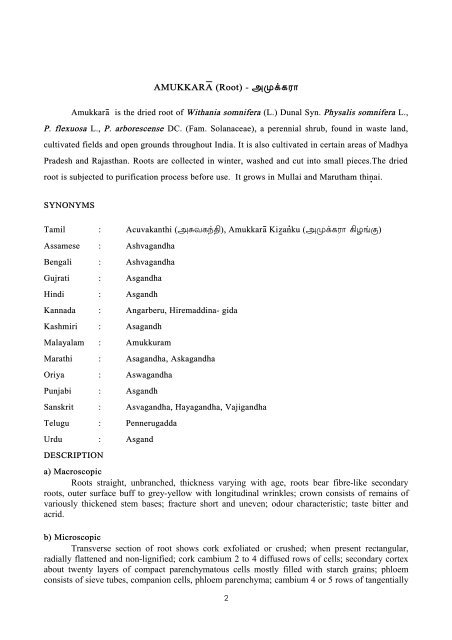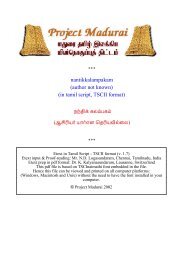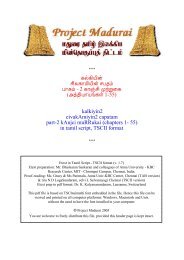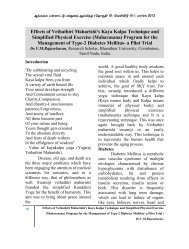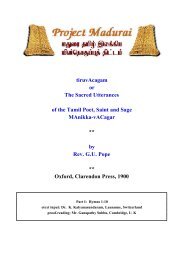- Page 1: THE SIDDHA PHARMACOPOEIA OF INDIA P
- Page 5 and 6: 2. AATRUTHUMMATI (UNRIPE FRUIT) Ë
- Page 7 and 8: Standard solution 1 mg of 2-O-β-D-
- Page 9 and 10: 3. ADA THODAI (LEAF) ËÙËTHÕÙAI
- Page 11 and 12: T.L.C. T.L.C. of Alcoholic extract
- Page 13 and 14: ectangular groups of stone cells ha
- Page 15 and 16: 5. ATHIMATHURAM (STOLON AND ROOT) A
- Page 17 and 18: Gu¸am : Noymai (ªï£Œ¬ñ), Ti
- Page 19 and 20: parenchymatous cells with intercell
- Page 21 and 22: 7. ATTHI PATTAI (BARK) ATTHIPPAÚÙ
- Page 23 and 24: IMPORTANT FORMULATIONS Karic¡lai I
- Page 25 and 26: long, back of standard petal pubesc
- Page 27 and 28: V¢rium : Veppam (ªõŠð‹) Piri
- Page 29 and 30: and rays; oil globules present in c
- Page 31 and 32: 10. SARAKKONDRAI PULI (FRUIT PULP)
- Page 33 and 34: dissolved in 25 ml of Methanol. T.L
- Page 35 and 36: of small cells; cambium ring distin
- Page 37 and 38: 12. SATHIKKAI (KERNEL) CËTHIKKËY
- Page 39 and 40: PROPERTIES AND ACTIONS Cuvai : K¡r
- Page 41 and 42: arranged 3 to 4 rows of cells; cork
- Page 43 and 44: 14. SEERAGAM (FRUIT) CÌRAKAM (Frui
- Page 45 and 46: IMPORTANT FORMULATIONS A¿·¡thic
- Page 47 and 48: Powder: Light yellow; shows thick w
- Page 49 and 50: 16. SIRUPEELAI SAMULAM (WHOLE PLANT
- Page 51 and 52: IDENTITY, PURITY AND STRENGTH Forei
- Page 53 and 54:
17. SOMBU (FRUIT) CÕMPU (Fruit) -
- Page 55 and 56:
Gu¸am : Ilaku (Þô°), Va¼a·ci
- Page 57 and 58:
vascular bundles and yellow secreti
- Page 59 and 60:
19. ELAVANGAM (FLOWER BUD) ILAVA×K
- Page 61 and 62:
T.L.C. T.L.C. of the Petroleum ethe
- Page 63 and 64:
Transverse section of bark (devoid
- Page 65 and 66:
IMPORTANT FORMULATIONS Kakkuv¡º I
- Page 67 and 68:
or groups; isolated large stone cel
- Page 69 and 70:
22. INJI (FRESH RHIZOME) IØCI (Fre
- Page 71 and 72:
V¢rium : Veppam (ªõŠð‹) Piri
- Page 73 and 74:
arely 3, cotyledonary leaves, embed
- Page 75 and 76:
24. KAKKANA VER (ROOT) KËKKAÛA V
- Page 77 and 78:
Curam/K¡yccal (²ó‹/裌„ê
- Page 79 and 80:
carbonate; mesophyll contains clust
- Page 81 and 82:
26. KANDANKATTHIRI SAMULAM (WHOLE P
- Page 83 and 84:
microsphenoidal crystals of calcium
- Page 85 and 86:
27. KARPOGARISI (FRUIT) KËRPÕKARI
- Page 87 and 88:
T.L.C. T.L.C. of the Alcoholic extr
- Page 89 and 90:
etween palisade and spongy parenchy
- Page 91 and 92:
29. KARUNCHEERAGAM (SEED) KARUØCÌ
- Page 93 and 94:
DOSE - Powder 500 mg - 4 g 30. KADU
- Page 95 and 96:
Cucurbitacin glycosides, Kutkoside,
- Page 97 and 98:
Powder: Blackish brown to black; sh
- Page 99 and 100:
32. KADUKKAI (FRUIT) KAÚUKKËY (Fr
- Page 101 and 102:
IMPORTANT FORMULATIONS Carapu´ka V
- Page 103 and 104:
cortex consists of 8 to 10 layers o
- Page 105 and 106:
34. KOLLU (SEED) KOßßU (Seed) -
- Page 107 and 108:
35. KOTTAM (ROOT) KÕÚÚAM (Root)
- Page 109 and 110:
IMPORTANT FORMULATIONS Amirt¡tik K
- Page 111 and 112:
Transverse section of fruit shows p
- Page 113 and 114:
37. KUNDRI MANI (SEED) KUÜÞIMAÛI
- Page 115 and 116:
DOSE - It cannot be administered as
- Page 117 and 118:
IDENTITY, PURITY AND STRENGTH Forei
- Page 119 and 120:
39. MANJAL (RHIZOME) MAØCAß (Rhiz
- Page 121 and 122:
PROPERTIES AND ACTIONS Cuvai : Kaip
- Page 123 and 124:
oxalate, stone cells also found sca
- Page 125 and 126:
THERAPEUTIC USES Cuvaiyiºmai (²¬
- Page 127 and 128:
80 to 180 mm in dia., present in mo
- Page 129 and 130:
42. MAVILINGAPATTAI (STEM BARK) MË
- Page 131 and 132:
Ceykai : Ka¼karaicci (èŸè¬ó
- Page 133 and 134:
cells packed with abundant, oval to
- Page 135 and 136:
44. MUKKIRATTAI SAMUALAM (WHOLE PLA
- Page 137 and 138:
Powder: Brown; shows parenchyma cel
- Page 139 and 140:
45. NANNARI (ROOT) NAÜÜËRI (Root
- Page 141 and 142:
IMPORTANT FORMULATIONS Ma¸·£r¡t
- Page 143 and 144:
anther, two celled, dorsifixed; gyn
- Page 145 and 146:
Cevin°y (ªêM«ï£Œ), C£takata
- Page 147 and 148:
tangentially elongated while rest o
- Page 149 and 150:
48. NELLIVATRAL (DRIED FRUIT) NELLI
- Page 151 and 152:
IMPORTANT FORMULATIONS ˺anta Pai
- Page 153 and 154:
) Microscopic Transverse section of
- Page 155 and 156:
50. NAERUNCHIVER (ROOT) NERUØCI V
- Page 157 and 158:
Pirivu : Iºippu (ÞQŠ¹) Ceykai :
- Page 159 and 160:
elongated, thin-walled cells; endos
- Page 161 and 162:
52. PARANGI CHAKKAI (TUBEROUS ROOT)
- Page 163 and 164:
53. PATHIRI VER (ROOT) PËTHIRI VÓ
- Page 165 and 166:
IMPORTANT FORMULATIONS Ma¸·£r¡t
- Page 167 and 168:
irregular, closely placed vascular
- Page 169 and 170:
55. PERUNGAYAM (OLEO-GUM-RESIN) PER
- Page 171 and 172:
CONSTITUENTS Dimethyl trisulphide,
- Page 173 and 174:
Root - Shows a single layer of epid
- Page 175 and 176:
57. PONNANGANI (WHOLE PLANT) POÜÜ
- Page 177 and 178:
Water-soluble extractive Not less t
- Page 179 and 180:
eyond it; corolla 2.5 to 3.0 mm. lo
- Page 181 and 182:
59. PUNGAM VERPATTAI (ROOT BARK) PU
- Page 183 and 184:
̽ai (߬÷), Irumal (Þ¼ñ), M
- Page 185 and 186:
Powder: Creamish- brown, oily; show
- Page 187 and 188:
61. POOVARASAM PATTAI (STEM BARK) P
- Page 189 and 190:
62. THAMARAI MALAR (FLOWER) TËMARA
- Page 191 and 192:
V¢rium : Ta·pam (î†ð‹) Piri
- Page 193 and 194:
consists of spherical cells enclosi
- Page 195 and 196:
64. THANRIKKAY (FRUIT) TËÜÞIKKË
- Page 197 and 198:
Civataic C£ra¸am (Cõ¬î„ Åó
- Page 199 and 200:
cuticle; mesocarp consists of large
- Page 201 and 202:
66. VAIVIDANGAM (FRUIT) VËYVIÚA×
- Page 203 and 204:
for five minutes at 105°C six spot
- Page 205 and 206:
Powder: Dark brown, oily; shows fra
- Page 207 and 208:
68. VALUZHUVAI (SEED) VËLUàUVAI (
- Page 209 and 210:
THERAPEUTIC USES C£takan°yka½ (
- Page 211 and 212:
IDENTITY, PURITY AND STRENGTH Forei
- Page 213 and 214:
70. VEPPAM PAZHAM (FRUIT) VÓPPAMPA
- Page 215 and 216:
THERAPEUTIC USES T°l N°yka½ («
- Page 217 and 218:
egular, thin-walled cells occasiona
- Page 219 and 220:
72. VEPPAM POO (FLOWER) VÓPPAM PÍ
- Page 221 and 222:
IMPORTANT FORMULATIONS T¡mpiraccen
- Page 223 and 224:
elements, fibres, parenchyma and cr


